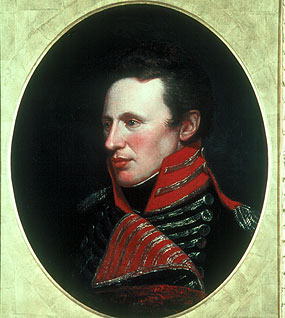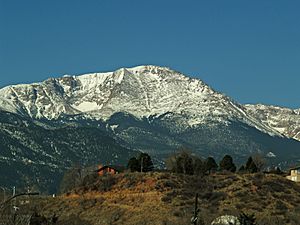Zebulon Pike facts for kids
Quick facts for kids
Zebulon Pike
|
|
|---|---|

Portrait by Charles Willson Peale, 1808
|
|
| Born |
Zebulon Montgomery Pike
January 5, 1779 Lamington, New Jersey, U.S.
|
| Died | April 27, 1813 (aged 34) York, Upper Canada (now Toronto, Ontario)
|
| Cause of death | Killed in action |
| Resting place | Military Cemetery, Sackets Harbor, New York |
| Occupation |
|
| Spouse(s) |
Clarissa Harlow Brown
(m. 1801) |
| Children | 5 |
| Relatives | Emory Jenison Pike (great nephew) |
| Signature | |
 |
|
Zebulon Montgomery Pike (born January 5, 1779 – died April 27, 1813) was an American general and explorer. He is famous because Pikes Peak in Colorado is named after him. As an officer in the U.S. Army, he led two important trips.
His first trip in 1805–1806 explored the northern parts of the Mississippi River. His second trip in 1806–1807 went southwest into areas near Spanish settlements in New Mexico and Texas. These trips happened at the same time as other famous explorations, like the Lewis and Clark Expedition.
Pike's second trip crossed the Rocky Mountains into what is now southern Colorado. Spanish officials captured him and his men near Santa Fe. They were sent to Chihuahua (in present-day Mexico) for questioning. Later in 1807, Pike and some of his men were released near American territory in Louisiana.
In 1810, Pike wrote a book about his adventures. It was very popular and translated into many languages. He became a brigadier general in the American Army. He fought in the War of 1812 and was killed during the Battle of York in April 1813. This battle took place near the British colonial capital of Upper Canada.
Contents
Early Life and Family
Growing Up and Joining the Army
Zebulon Pike was born on January 5, 1779, in Lamington, New Jersey. His father, also named Zebulon Pike, was a military officer. Young Zebulon followed in his father's footsteps. His family lived in different military outposts in Ohio and Illinois. These areas were the "northwestern frontier" of the United States back then.
Pike joined the army in 1799 as a second lieutenant. He was quickly promoted to first lieutenant later that same year.
Marriage and Children
In 1801, Pike married his cousin, Clarissa Harlow Brown. They had one child who lived to be an adult, Clarissa Brown Pike. She later married the son of William Henry Harrison, who became a U.S. President. Pike and Clarissa had four other children who sadly died young.
Military Expeditions
First Trip: Exploring the Mississippi River
In the summer of 1805, General James Wilkinson ordered Lieutenant Pike to find the source of the Mississippi River. He also needed to explore the northern part of the new Louisiana Territory. Another goal was to remove any British or Canadian fur traders who were illegally trading in the new American lands.
Pike left St. Louis on August 9, 1805. He and his crew traveled upstream in a large boat called a pirogue. On September 21, they reached where the Mississippi and Minnesota Rivers meet. Here, Pike made a deal with the native Dakota people. He bought land that would later become Fort Snelling.
The group continued up the river. They built a winter camp near Little Falls, Minnesota. In December, they walked along the frozen river, visiting British fur trading posts. At Leech Lake, Pike told the traders they were in U.S. territory. He said they had to follow American laws. He also met with Ojibwe chiefs and asked them to make peace with the Dakota. On February 10, they took down the British flag and raised an American flag. Pike explored further, naming Upper Red Cedar Lake (now Cass Lake) as the source of the Mississippi.
Pike and his men left Leech Lake on February 18. They carried peace gifts from the Ojibwe to the Dakota. They returned to St. Louis on April 20, 1806. This was the second U.S. government expedition into the new western lands, and the first to return.
Second Trip: The Southwest Expedition

Soon after his first trip, General Wilkinson sent Pike on a second one. This time, he was to explore the Southwest. His mission was to map the area and find the beginnings of the Arkansas River and Red River of the South. He also needed to learn about the natural resources and make friends with Native American tribes.
This trip, known as the "Pike Expedition," started on July 15, 1806. Some historians believe this mission was also to gather information for a possible American invasion of Spanish areas like New Mexico and Texas. This was because of disagreements over the border of the Louisiana Purchase.
In November 1806, Pike and his team saw a tall mountain, which was later named Pikes Peak. They tried to climb it but had to stop because of deep snow and lack of food. They made it to Mt. Rosa, southeast of Pikes Peak.
They then continued south, looking for the Red River. They built a small fort for shelter during winter. However, they had crossed into Spanish territory, either by mistake or on purpose. Spanish authorities captured Pike and some of his group on February 26, 1807.
Pike and his men were taken to Santa Fe, the capital of the Spanish province of New Mexico. Then they were moved further south to Chihuahua City in Chihuahua province. Pike was treated well, even invited to dinners, but his men were kept as prisoners. Spanish officials were worried about American democracy and Protestant religions spreading into their lands.
During his time there, Pike saw many maps of the Southwest and New Spain. He also learned that many people in colonial Mexico were unhappy with Spanish rule. Spain protested to the United States about Pike's expedition. But since the countries were not at war, the Spanish governor released the Americans. Pike and most of his men were escorted back north and released at the Louisiana border on July 1, 1807.
Later Military Career
War of 1812
Pike was promoted to captain during his trip to the Southwest. In 1811, he fought in the Battle of Tippecanoe under General William Henry Harrison. He became a colonel in July 1812. He also served as a deputy quartermaster and inspector general during the War of 1812.
In November 1812, Pike led the advance group of American forces in the first Battle of Lacolle Mills. The Americans were defeated, partly due to poor planning by their commander. Pike was promoted to brigadier general in March 1813.
Pike's last military campaign was a successful attack on York (now Toronto) on April 27, 1813. As Pike's troops approached Fort York, the British blew up their ammunition storage. Pike was killed by flying rocks and debris, along with many other American soldiers. His body was taken by ship back to Sackets Harbor, where he was buried in the military cemetery.
Pike's Writings and Legacy
Confiscated Papers and Published Book
The Spanish authorities took some of Pike's papers. These papers were not returned to the United States until the 20th century. Pike wrote a book about his expeditions, even recreating some parts from memory. It was published in 1810 as The expeditions of Zebulon Montgomery Pike to Headwaters of the Mississippi River, through Louisiana Territory, and in New Spain, during the Years 1805–6–7.
This book and his maps gave Americans important information about trade routes, like the future Santa Fe Trail. It was very popular and was translated into Dutch, French, and German. It became a must-read for other American explorers in the 1800s.
Pike's capture by the Spanish and his travels through the Southwest gave him special knowledge about the region. For example, he wrote about the political situation in Chihuahua, which later led to the Mexican War of Independence. He also described trade in Spanish New Mexico and Chihuahua.
There is a legend in some parts of North America called The Lost City of Palanor or Zebulon's Gift. This myth is said to come from a missing part of Pike's journals. The story tells of Pike finding a great treasure and then discovering a lost city called "Palanor," supposedly built by early European settlers. He then decided to hide the treasure there.
Pike's Enduring Impact
After Pike died in battle, people widely celebrated his military achievements. There were biographies, memorials, paintings, poems, and songs about him. Many towns, counties, and ships were named after him. His fame lessened after the Civil War but grew again in 1906, for the 100th anniversary of his Southwest Expedition.
In the 1900s, his reputation focused on his explorations. His name appeared on natural places like dams, islands, lakes, and parks. Pikes Peak is still one of the most visited mountains in the world. The route of Pike's expedition, about 3,664 miles long, is still maintained today by the Pike National Trail Association.
In 1901, General William Jackson Palmer honored Pike with a marble statue. It was placed near the entrance of the Antlers Hotel in Colorado Springs. In 1926, a bronze medallion portrait of Pike was placed at Tahama Spring in Monument Valley Park, Colorado Springs. For over 200 years, historians have wondered if Pike was truly just an explorer, or if he was also a spy.
Places Named After Zebulon Pike
- Fort Pike
- Camp Pike, Arkansas (part of Robinson Maneuver Training Center)
- USS General Pike
- A building at Fort Knox is named for him.
- Liberty ship SS Zebulon Pike
Landforms
- Pike Bay
- Pike Creek
- Pike Island at the meeting point of the Mississippi and Minnesota Rivers in Fort Snelling State Park, Minnesota
- Pikes Peak
- Zebulon Pike Lake Reservoir in Morrison County, Minnesota
Communities
- Pike County in:
- Pike, New York
- Piketon, Ohio
- Pikeville, Kentucky
- Pikesville, Kentucky (historic)
- Pikeville, Tennessee
- Pikesville, Maryland
- Pike Bay Township, Cass County, Minnesota
- Pike Creek Township, Morrison County, Minnesota
- Pike Township, Marion County, Indiana
- Pike Township, Wyoming County, New York
- Pike Township, Stark County, Ohio
- Zebulon, Kentucky
Other Places
- Pike National Forest in Colorado
- Pikes Peak Marathon in Colorado
- Pikes Peak State Park in Clayton County, Iowa
- Pike Trail League, Kansas high school sports league
- Pike Valley School District, Kansas School District, U.S.D. 426
- General Zebulon Pike Lock and Dam No. 11 in Dubuque, Iowa
- SRAM's RockShox division, which makes bike parts, has named some shocks "Zeb" and "Pike."
- Zebulon Ice, a Colorado Department of Transportation snowplow, named by a child in a contest.
Images for kids
See also
 In Spanish: Zebulon Pike para niños
In Spanish: Zebulon Pike para niños

